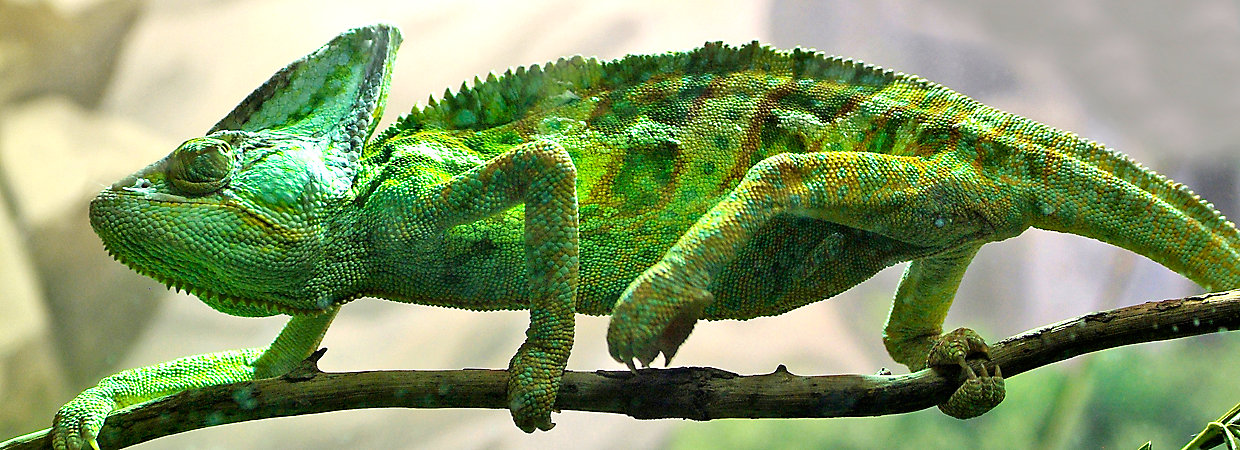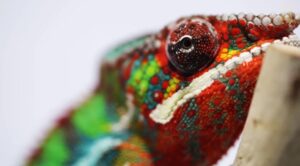A veiled chameleon requires a tank of at least 36 inches tall by 24 inches by 24 inches. Juvenile chameleons can start in smaller habitats, a minimum of 16 inches by 16 inches by 30 inches.
Veiled chameleons thrive in vertically-oriented enclosures that support their tree-dwelling nature. Providing ample space is crucial for these arboreal reptiles, as it enables them to climb, explore, and display natural behaviors. Owners must ensure the tank is well-ventilated, secure, and equipped with branches and foliage for climbing and hiding.
The habitat should also accommodate temperature gradients and proper UVB lighting essential for their health. Regular tank maintenance is necessary to maintain an environment that’s both stimulating and safe for the veiled chameleon, reflecting their natural habitat as closely as possible. Proper setup and size directly influence the well-being and longevity of these fascinating, color-changing reptiles.
Sizing Up The Perfect Habitat
Choosing the right home for a veiled chameleon is crucial. These colorful reptiles need space to climb, hide, and explore. To keep them healthy and happy, let’s discover the ideal tank size for your scaly friend.
Factors Influencing Tank Size
Your chameleon’s home affects their mood and health. Consider these key points:
- Chameleon Size: Larger chameleons need bigger tanks.
- Activity Level: Active chameleons require more space to move.
- Accessories: Plants and branches take up room.
- Growth: Plan for your pet’s growth over time.
Minimum Tank Requirements
A veiled chameleon’s tank should be tall and wide. Here’s what they need:
| Chameleon Age | Tank Size (LxWxH) |
|---|---|
| Baby | 16″ x 16″ x 30″ |
| Juvenile | 18″ x 18″ x 36″ |
| Adult | 24″ x 24″ x 48″ or larger |
Remember, these sizes are the minimum. More space is always better for your chameleon to thrive.

Credit: www.petsmart.com
Growth And Tank Size Correlation
Understanding the growth and tank size correlation for veiled chameleons is key. As they develop, their space requirements change. This is crucial for their health and happiness. It’s important to get the tank size right from the start.
Juvenile Vs. Adult Chameleon Needs
A young veiled chameleon starts small but grows quickly. They need space to explore and climb. But their space should not be too big to find food and heat. Adult chameleons need larger tanks to move freely and display natural behaviors.
| Age | Tank Size |
|---|---|
| Juvenile | Minimum 16x16x30 inches |
| Adult | Minimum 24x24x48 inches |
Planning For Growth
Think ahead for a chameleon’s growth when choosing a tank. Bigger is better to support their size as they mature. Ensure the tank’s height allows for vertical movement which is crucial for their well-being.
- Select a tall tank for climbing
- Ensure easy access to heat and UVB
- Plan for changes in tank setup as they grow
Going Beyond The Basics
Creating a thriving habitat for a veiled chameleon involves more than just the size of the tank. It’s about understanding and catering to their unique needs for space, ventilation, and environment. To truly give your veiled chameleon the quality of life it deserves, let’s explore the essential components for their enclosure. Engaging with these elements ensures your pet doesn’t just survive but thrives.
Vertical Space: Why It Matters
Veiled chameleons are natural climbers. They spend a lot of time in trees. Their enclosures need to reflect this behavior. A tall tank is essential for them to feel at home. With proper vertical space, your chameleon can:
- Climb: They love to move upwards. It keeps them active and healthy.
- Bask: They need to get close to heat sources. Height allows them to regulate their temperature.
- Hide: Higher spaces offer privacy. This helps reduce stress levels.
Consider a tank that is at least 24 inches tall. This will give your pet enough room to explore and stretch.
The Importance Of Proper Ventilation
Chameleons require fresh air to breathe and prevent disease. A well-ventilated tank prevents stagnant air that can harbor bacteria and fungi. When selecting a tank, look for these features:
- Mesh sides: This promotes air flow. It helps keep the environment fresh.
- Open top: It allows heat to escape. Cooler air can circulate in.
An enclosure with both a mesh side and open top works best. It ensures your pet always has fresh air.

Credit: www.amazon.com
Setting Up Your Chameleon’s New Home
Welcome to the vibrant world of veiled chameleons, where creating the perfect environment is key to their health and happiness. Understanding the size and setup of your new pet’s home is crucial. This section breaks down the essentials needed when arranging a comfortable habitat for your veiled chameleon.
Substrate And Furnishings
Let’s start with the foundation: the substrate. It’s the bed of your chameleon’s terrarium and plays a vital role in maintaining moisture. Safe substrates include:
- Reptile carpet
- Coconut fiber
- Organic soil (free from fertilizers and pesticides)
Furnishings make the space livable and fun. They allow your pet to climb, hide, and bask as it would in the wild. Include:
- Sturdy branches
- Non-toxic plants
- Basking rocks
- Hiding places
Temperature, Lighting, And Humidity Control
Chameleons require precise conditions to thrive. Here’s what’s needed:
| Feature | Requirement |
|---|---|
| Temperature Gradient | 72-80°F during the day, 60-70°F at night |
| UVB Lighting | Mandatory for calcium metabolism and overall health |
| Humidity Levels | 50-70%, monitored with a hygrometer |
Use a digital thermometer to monitor temperatures. Place UVB lights above the enclosure. Mist the habitat regularly to maintain humidity.
Maintenance And Upkeep Of The Habitat
Creating an ideal home for your veiled chameleon involves more than just setting up a tank; it requires regular maintenance and careful monitoring. Keeping the habitat clean, safe, and comfortable is essential to your pet’s health and well-being. Let’s dive into the details of maintaining a pristine environment for your scaley friend.
Cleaning Schedules
Consistency is key when it comes to cleaning. A routine schedule ensures a hygienic habitat for your veiled chameleon.
| Daily Tasks | Weekly Tasks | Monthly Tasks |
|---|---|---|
|
|
|
Monitoring And Adjusting Habitat Conditions
Proper habitat conditions promote health and mimic a natural environment. Use tools to track and adjust these elements.
- Thermometers measure temperature.
- Hygrometers track humidity levels.
- Adjust lighting and heating as needed.
- Ensure adequate ventilation is maintained.
- Monitor plant health within the habitat.
Always observe your chameleon for signs of stress or discomfort. Adjustments to the habitat may be necessary to keep them thriving.
:strip_icc()/chameleons-t2-1236756-hero-ce561001842e44fa839282ce1644a1bc.jpg)
Credit: www.thesprucepets.com
Frequently Asked Questions For How Big Of A Tank Does A Veiled Chameleon Need?
What Is The Best Size Tank For Veiled Chameleon?
The ideal tank size for a veiled chameleon is a minimum of 24x24x48 inches, ensuring adequate space for climbing and foliage.
Is A 20 Gallon Tank Big Enough For A Chameleon?
A 20-gallon tank is too small for a chameleon. Adult chameleons require larger enclosures, around 50-100 gallons, to thrive.
Can A Veiled Chameleon Live In A 10 Gallon Tank?
No, a veiled chameleon requires at least a 20-gallon tank to thrive. A 10-gallon tank is too small for an adult chameleon’s space and ventilation needs.
How Big Of A Habitat Does A Veiled Chameleon Need?
A veiled chameleon requires a minimum habitat size of 2 feet by 2 feet by 4 feet to ensure sufficient space for movement, climbing, and thermoregulation. Larger enclosures are recommended for optimal health.
Conclusion
Selecting the right tank for your veiled chameleon is crucial for its health and happiness. Aim for an enclosure that provides ample space for climbing and foliage. Remember, a habitat that mirrors their natural environment promotes wellness. Tailor your choice to their growth and activity levels, ensuring a thriving pet for years to come.

